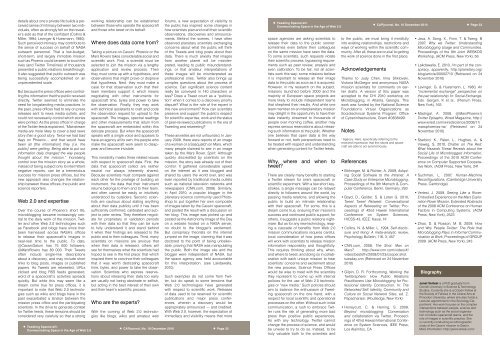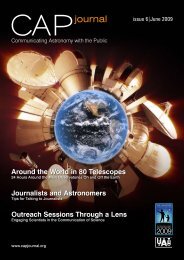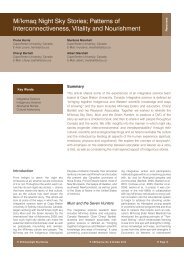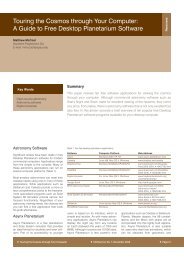Tweeting Spacecraft - Communicating Astronomy with the Public ...
Tweeting Spacecraft - Communicating Astronomy with the Public ...
Tweeting Spacecraft - Communicating Astronomy with the Public ...
You also want an ePaper? Increase the reach of your titles
YUMPU automatically turns print PDFs into web optimized ePapers that Google loves.
details about one’s private life builds a perceivedsense of intimacy between two individuals,often as strongly felt on <strong>the</strong> revealer’sside as that of <strong>the</strong> confidant (Collins &Miller, 1994; Levinger & Huesmann, 1980).Such perceived intimacy may contribute to<strong>the</strong> sense of success on behalf of NASAoutreach personnel. That a low-budget,short-term, and largely immobile missionsuch as Phoenix could be seen to touch <strong>the</strong>lives (and Twitter Timelines) of thousandspresented a public relations breakthrough.It also suggested that public outreach wasbeing successfully accomplished on anunprecedented scale.But because <strong>the</strong> press offices were controlling<strong>the</strong> information that <strong>the</strong> public receiveddirectly, Twitter seemed to eliminate <strong>the</strong>need for longstanding media practices. In<strong>the</strong> past, press offices had to rely on pressreleases sent to news media outlets, andcould not necessarily control which storieswere printed. As <strong>the</strong> press officer in chargeof <strong>the</strong> Twitter feeds explained, “Mainstreammedia are more likely to cover a bad newsstory than a good story. Twice we had baddays on Phoenix… and that would havebeen all [<strong>the</strong> information] <strong>the</strong>y [i.e. <strong>the</strong>public] were getting. Being able to put outinformation daily changed <strong>the</strong> way peoplethought about <strong>the</strong> mission.” Increasingcontrol over <strong>the</strong> mission story as a whole,instead of being subject only to intermittentnegative reports, can be a tremendoussuccess for mission press offices, but <strong>the</strong>new approach also changes <strong>the</strong> relationshipbetween <strong>the</strong>se offices, <strong>the</strong> public andscience reporters.Web 2.0 and expertiseOver <strong>the</strong> course of Phoenix’s short life,microblogging became increasingly centralto <strong>the</strong> daily work of <strong>the</strong> mission. Twitterand o<strong>the</strong>r Web 2.0 technologies suchas Facebook and blogs have since <strong>the</strong>nbeen harnessed across NASA’s officesto release <strong>the</strong>ir spacecraft’s images innear-real time to <strong>the</strong> public. To date,@CassiniSaturn has 75 000 followers;@MarsRovers has 80 000. Their Tweetsoften include single-line descriptionsabout a discovery, and may include shortlinks to blog posts, images or publishedpapers. As Tweets are retweeted, URLsclicked and blog RSS feeds generated,word of a spacecraft’s activities spreadsquickly. But while this may seem like adream come true for press offices, it isimportant to note that Web 2.0 technologiessuch as wikis and blogs have in <strong>the</strong>past exacerbated a tension between <strong>the</strong>mission press office and <strong>the</strong> participatingscientists. In <strong>the</strong> drive to generate contextfor Twitter feeds, <strong>the</strong>se tensions should beconsidered very carefully so that a strong• <strong>Tweeting</strong> <strong>Spacecraft</strong>:<strong>Communicating</strong> Space in <strong>the</strong> Age of Web 2.0working relationship can be establishedbetween those who operate <strong>the</strong> spacecraftand those who tweet on its behalf.Where does data come from?Taking a picture on Cassini, Phoenix or <strong>the</strong>Mars Rovers takes considerable social andscientific work. First, a scientist must beselected to join <strong>the</strong> mission via a lengthyapplication and review process. Then<strong>the</strong>y must come up <strong>with</strong> a hypo<strong>the</strong>sis, andobservations that might prove or disprovethat hypo<strong>the</strong>sis. Next, <strong>the</strong>y must make acase for that observation such that <strong>the</strong>irteam members support it, which meansnegotiating <strong>with</strong> o<strong>the</strong>r instruments forspacecraft time, bytes and power to take<strong>the</strong> observation. Finally, <strong>the</strong>y may work<strong>with</strong> technical assistants to craft and code<strong>the</strong> observation request for upload to <strong>the</strong>spacecraft. The images, spectral readingsand o<strong>the</strong>r measurements that return from<strong>the</strong> spacecraft are embedded <strong>with</strong>in thisdelicate process. But when <strong>the</strong> spacecraftspeaks <strong>with</strong> a single voice and appears tohave an agency all its own, <strong>the</strong> people whomake <strong>the</strong> spacecraft work seem to disappearand become invisible.This invisibility masks three related issues<strong>with</strong> respect to spacecraft data. First, <strong>the</strong>data that spacecraft collect are nei<strong>the</strong>rneutral nor always inherently shared.Because scientists must compete againsteach o<strong>the</strong>r for <strong>the</strong> privilege of building aninstrument, <strong>the</strong> data that <strong>the</strong>ir instrumentreturns belongs to <strong>the</strong>m and to <strong>the</strong>ir team,and often cannot be easily or intuitivelyunderstood by outsiders. Second, scientistsare cautious about stating anythingabout <strong>the</strong>ir data publicly until it has beensufficiently confirmed, calibrated and subjectto peer review. They <strong>the</strong>refore negotiatefor proprietary or validation periods<strong>with</strong> <strong>the</strong>ir data so that <strong>the</strong>y can be sureto fully understand it and stand behindit when <strong>the</strong>ir findings are released to <strong>the</strong>public and to <strong>the</strong>ir colleagues. Third, manyscientists on missions are anxious thatwhen <strong>the</strong>ir data is released, o<strong>the</strong>rs willsee for <strong>the</strong>mselves what <strong>the</strong> scientists hadhoped to see in <strong>the</strong> first place: that whichinspired <strong>the</strong>m to convince <strong>the</strong>ir colleaguesthat it was worth dedicating spacecrafttime, bytes, and power to take <strong>the</strong> observation.Scientists who express reservationsabout releasing <strong>the</strong>ir data too earlyare usually not being obstinate or selfish,but acting in <strong>the</strong> best interest of <strong>the</strong>ir ownand <strong>the</strong>ir team’s scientific process.Who are <strong>the</strong> experts?With <strong>the</strong> coming of Web 2.0 technologieslike blogs, wikis and amateur webforums, a new expectation of visibility to<strong>the</strong> public has inspired some changes inhow scientists plan and craft <strong>the</strong>ir scientificobservations, discoveries and announcements.Behind <strong>the</strong> scenes, I have oftenobserved planetary scientists exchangingconcerns about what <strong>the</strong> public will thinkof <strong>the</strong> Tweets and blog posts about <strong>the</strong>irdata. There is much anxiety that imagesfrom ano<strong>the</strong>r planet will be misinterpreted,leading to public misunderstandings,or that amateur interpretations of<strong>the</strong>se images will be misinterpreted asprofessional ones. Twitter also brings upcomplex questions about <strong>the</strong> process ofscience. Can significant science contentreally be conveyed in 140 characters orless? Does a Tweet count as a “publication”when it comes to a discovery prioritydispute? What is <strong>the</strong> role of <strong>the</strong> expert inthis new environment? How can scientistspreserve and support <strong>the</strong> public’s respectfor scientific expertise, work and <strong>the</strong> statusof peer-reviewed publications in <strong>the</strong> era of<strong>Tweeting</strong> and retweeting?These anxieties are not unfounded. In January2008, <strong>the</strong>re were reports of an imageof a woman or a Sasquatch on Mars, whichmany people claimed to see in an imagetaken by <strong>the</strong> Mars Rover, Spirit. Althoughquickly discredited by scientists on <strong>the</strong>mission, <strong>the</strong> story was already out of <strong>the</strong>ircontrol. It ga<strong>the</strong>red considerable speedon <strong>the</strong> internet as it was blogged andshared by users <strong>the</strong> world over, and waseven reported by traditional media outletssuch as national television networks andnewspapers (CNN.com, 2008). Similarly,in April 2010, a popular blogger in <strong>the</strong>planetary science community used Photoshopto put toge<strong>the</strong>r her own compositeof images taken by <strong>the</strong> Cassini spacecraft,and posted <strong>the</strong> result <strong>with</strong> a discussion onher blog. This image was picked up andposted as <strong>the</strong> <strong>Astronomy</strong> Image of <strong>the</strong> Dayon a website hosted on a NASA server,no doubt to <strong>the</strong> blogger’s excitement.But conspiracy <strong>the</strong>orists on <strong>the</strong> internetjumped on <strong>the</strong> image, claiming that it wasdoctored to <strong>the</strong> point of being unbelievable,proving that NASA was manipulating<strong>the</strong> public. Both <strong>the</strong> image site and <strong>the</strong>blogger were independent of NASA, but<strong>the</strong> space agency was held accountablefor this interpretation. (see Lakdawalla,2010).Such examples do not come from Twitter,but do speak to some tensions thatWeb 2.0 technologies have generated<strong>with</strong> respect to scientific work. Releasesof data used to be reserved for scientificpublications and major press conferences,wherein a discovery would beappropriately announced — and credited.With Web 2.0, however, <strong>the</strong> expectation ofimmediacy and visibility means that more• CAPjournal, No. 10 December 2010 • Page 32• <strong>Tweeting</strong> <strong>Spacecraft</strong>:<strong>Communicating</strong> Space in <strong>the</strong> Age of Web 2.0space agencies are asking scientists torelease <strong>the</strong>ir data to <strong>the</strong> public sooner:sometimes even before <strong>the</strong>ir colleagueson <strong>the</strong> same mission have seen <strong>the</strong> data.To some scientists, such requests violate<strong>the</strong>ir scientific process, bypassing requirementssuch as peer review, analysis andeven calibration. To be fair, not all scientistswork this way: some missions believeit is important to release all <strong>the</strong>ir imagedata to <strong>the</strong> public as soon as it is acquired.However, in my research on <strong>the</strong> subject,missions launched before 2000 and <strong>the</strong>majority of European space projects aremore likely to include independent teamsthat shepherd <strong>the</strong>ir results. And while oneteam member on an interplanetary missionmay delight in <strong>the</strong> opportunity to have <strong>the</strong>irdata instantly streamed to thousands ofpeople over morning coffee, ano<strong>the</strong>r mayexpress serious reservations about releasingsuch information to <strong>the</strong> public. Whe<strong>the</strong>rone believes that open data is <strong>the</strong> wayforward or not, both perspectives need tobe treated <strong>with</strong> respect and understandingwhen generating content for Twitter feeds.Why, where and when totweet?There are clearly many benefits to startinga Twitter stream for one’s spacecraft orscientific experiment. With a few short keystrokes,a single message can be relayeddirectly to followers around <strong>the</strong> world, bypassing media relations, and allowing <strong>the</strong>public to build an intimate relationship<strong>with</strong> <strong>the</strong>ir spacecraft. For some, this is adream come true, ensuring <strong>the</strong>ir mission’ssuccess and continued public support; foro<strong>the</strong>rs, it suggests a public relations nightmare.But as for any new technology, reapinga cascade of benefits from Web 2.0mission communications requires careful,local consideration of how press officeswill work <strong>with</strong> scientists to release missioninformation responsibly and thoughtfully.This requires thinking about why, when,and where to tweet, and doing so in collaboration<strong>with</strong> each unique mission to hearscientists’ concerns and excitement about<strong>the</strong> new process. Science Press Officeswould be wise to meet <strong>with</strong> <strong>the</strong> scientists<strong>the</strong>y represent to come up <strong>with</strong> internalpolicies for <strong>the</strong> use of Web 2.0 technologiesor “new media.” Such policies shouldaim to balance <strong>the</strong> enthusiasm of <strong>Tweeting</strong>spacecraft on <strong>the</strong> one hand, <strong>with</strong> arespect for local scientific and operationalprocesses on <strong>the</strong> o<strong>the</strong>r. Without such initialcommunication, a rush to embrace Twitterruns <strong>the</strong> risk of generating more badpress than positive public experiences.As <strong>with</strong> any technology, Twitter cannotchange <strong>the</strong> process of science, and wouldbe unwise to try to do so. Instead, to betruly valuable both to <strong>the</strong> scientists andto <strong>the</strong> public, we must bring it mindfullyinto existing relationships, restrictions andways of working <strong>with</strong>in <strong>the</strong> scientific community.After all, <strong>the</strong>se are crucial to getting<strong>the</strong> work of science done in <strong>the</strong> first place.AcknowledgementsThanks to Judy Chen, Irina Shklovski,Victoria McGregor and anonymous NASAmission scientists for comments on earlierdrafts. A version of this paper wasaccepted to <strong>the</strong> CHI 2010 workshop onMicroblogging, in Atlanta, Georgia. Thiswork was funded by <strong>the</strong> National ScienceFoundation’s Virtual Organizations asSociotechnical Systems Program: Officeof Cyberinfrastructure, Grant #0838499.Notes1Agency: Here, specifically referring to <strong>the</strong>received impression that <strong>the</strong> robots and spacecraftare able to act autonomously.References• CAPjournal, No. 10 December 2010 • Page 33• Böhringer, M. & Richter, A. 2009, AdoptingSocial Software to <strong>the</strong> Intranet: ACase Study on Enterprise Microblogging,Proceedings of <strong>the</strong> 9th Mensch & ComputerConference, Berlin, Germany, 293• Boyd, D., Golder, S. & Lotan G. 2010,Tweet Tweet Retweet: ConversationalAspects of Retweeting on Twitter, Proceedingsof 42nd Hawaii InternationalConference on System Sciences,HICSS-43, IEEE: Kauai, HI• Collins, N. & Miller, L. 1994, Self-disclosureand liking: A meta-analytic review,Psychology Bulletin, 116, 3, 457• CNN.com, 2008, The Shot: Man onMars?, http://www.cnn.com/video/#/video/bestoftv/2008/01/23/cooper.shot.tuesday.cnn (Retrieved on 24 November2010)• Gilpin, D. R. Forthcoming, Working <strong>the</strong>Twittersphere: How <strong>Public</strong> RelationsPractitioners Use Microblogging for ProfessionalIdentity Construction, In: TheNetworked Self: Identity, Community andCulture on Social Network Sites, ed. Z.Papacharissi, (Routledge, New York)• Honeycutt, C. & Herring, S. 2009,Beyond microblogging: Conversationand collaboration via Twitter, Proceedingsof 42nd Hawaii International Conferenceon System Sciences, IEEE Press,Los Alamitos, CA• Java, A, Song, X., Finin, T. & Tseng, B2007, Why we Twitter: UnderstandingMicroblogging Usage and Communities,Proceedings of <strong>the</strong> 9th Joint WEBKDDWorkshop, (ACM Press, New York), 56• Lakdawalla, E. 2010, I’m part of <strong>the</strong> conspiracy,apparently, http://planetary.org/blog/article/00002710 (Retrieved on 24November 2010)• Levinger, G. & Huesmann, L. 1980, An“incremental exchange” perspective on<strong>the</strong> pair relationship. In: Social Exchange,Eds. Gergen, K et al., (Plenum Press,New York), 165• Madrigal, A. 2008, @MarsPhoenix’sTwitter Epitaphs, Wired Magazine, http://www.wired.com/wiredscience/2008/11/marsphoenixs-tw/ (Retrieved on 24November 2010)• Starbird, K., Palen, L., Hughes, A. &Vieweg, S. 2010, Chatter on The Red:What Hazards Threat Reveals about <strong>the</strong>Social Life of Microblogged Information,Proceedings of <strong>the</strong> 2010 ACM Conferenceon Computer Supported CooperativeWork, (ACM Press, New York), 241• Suchman, L. 2007, Human-MachineReconfigurations, (Cambridge UniversityPress, Cambridge)• Vertesi, J. 2009, Seeing Like a Rover:Embodied Experience on <strong>the</strong> Mars ExplorationRover Mission, Extended Abstractsof <strong>the</strong> 2008 ACM Conference on HumanFactors in Computing Systems, (ACMPress, New York), 2523• Zhao, D. & Rosson, M. B. 2009, Howand Why People Twitter: The Role thatMicroblogging Plays in Informal Communicationat Work, Proceedings of GROUP2009. (ACM Press, New York), 243BiographyJanet Vertesi is a PhD graduate fromCornell University in Science & TechnologyStudies. Currently she is a Cotsen Fellow at<strong>the</strong> Society of Fellows in <strong>the</strong> Liberal Arts atPrinceton University, where she also holds aLecturer appointment in <strong>the</strong> Sociology Department.Her work focuses on <strong>the</strong> complexintersections between people, science andtechnology such as <strong>the</strong> social organisationof robotic spacecraft teams, and <strong>the</strong>role of images in scientific practice. Sheis currently conducting an ethnographicstudy of <strong>the</strong> Cassini mission to Saturn.More information: http://janet.vertesi.com/









